What To Look For In Camera
What photographic camera should I purchase? How to choose the right camera for photography or video
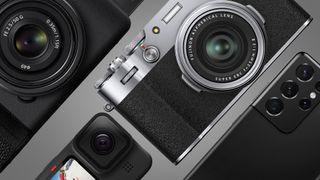
Trying to make up one's mind which camera you should buy? This is the guide you lot demand. From action cams and travel compacts to mirrorless models and total-frame flagships, our expert guide covers almost every kind of photographic camera you lot tin can buy in 2022.
Choosing the right type of photographic camera can be tricky. With and then many formats on offer, spanning such a wide range of budgets and features, information technology's piece of cake to be overwhelmed by choice. To assist you lot narrow down the options, we've shared our meridian tips for selecting the right kind of camera for your needs.
Because we regularly review and rank the latest releases across all camera categories, we're very familiar with what each type of camera tin offering for unlike photographers. Every bit photography enthusiasts ourselves, nosotros also know what the well-nigh important considerations are when deciding which format is right for you, including budget limitations and lens availability.
In the following step-by-step guide, nosotros'll outline the highlights and limitations of each type of camera to give y'all the full flick in a few short paragraphs. We'll also recommend our favorite photographic camera model in that genre. So once you've landed on the right type of photographic camera, you'll have a shortcut to the top option.
We'll start with the basics and work up through more advanced cameras, ending with gear that's fit for professionals. So whether you're wondering which format best suits your style of photography, or trying to decide between ii specific camera categories, this guide should help y'all make the right choice.
1. Should I stick with my smartphone?
It'southward no secret that smartphone photography has come on leaps and bounds in the final decade. The best smartphones in 2022 can capture images as well equally any regular point-and-shoot, plus their connectivity ways information technology'southward piece of cake to share your snaps straight to social media.
The top mobile options at present ship with multiple lenses to suit all sorts of shooting scenarios. The iPhone 13 Pro, for example, features iii lenses, each defended to a unlike scene: besides the main sensor, there's an ultra-wide and a telephoto lens. This means you become a lot of versatility from a device that can yet sideslip hands into your pocket.
What'southward more, the all-time smartphones today deploy AI smarts to help enhance your images automatically, whether that's portrait modes for shooting sharp profiles or nighttime settings that allow yous to capture sharp, vivid shots after dark. Certain flagship smartphones also offer a degree of manual command, such as Samsung'south Pro Fashion.
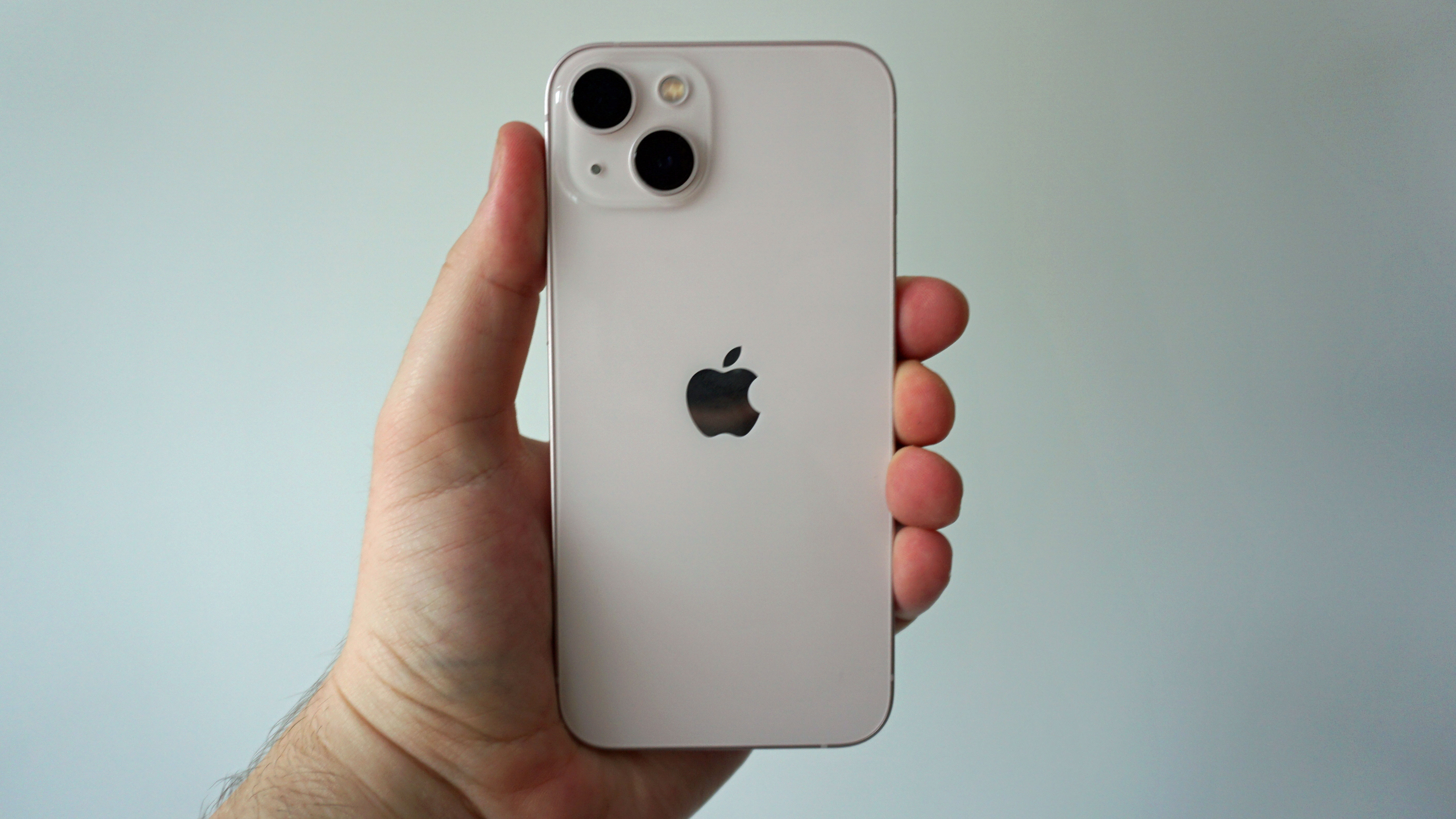
Smartphones likewise make information technology incredibly easy to edit and share images, thanks to their comprehensive connectivity options and app support. With higher resolutions than ever (the Samsung Milky way S21 Ultra features a 108MP chief sensor, for example) you shouldn't come up short when shooting images for social media.
And then smartphone cameras are more than capable than e'er. Only there are still a few compromises to consider. Smartphone sensors are smaller than what you lot'll find on premium compact cameras (and larger formats), which can limit depression-light noise performance and ultimate epitome quality.
And while a few flagship smartphones do now offer optical zoom (the Samsung Galaxy S21 Ultra features 10x zoom on i of its lenses), the range of more affordable smartphones is pretty limited compared to the kind of flexibility offered past travel compacts and dedicated telephoto lenses for DSLR and mirrorless models.
If you're mainly looking to shoot images for social media, information technology probably makes sense to stick with your smartphone, or upgrade to one with a better assortment (rather than ownership a dedicated camera). You're most likely to rely on your smartphone for capturing life as it happens, considering it's the tool yous'll almost always have with you.
Pros: Information technology's the camera you always have to hand, the results can match those from a regular point-and-shoot compact photographic camera, you tin share instantly to Facebook, Twitter and Instagram, you can become apps with astonishing furnishings and additional tools and they can exist piece of cake to use.
Cons: In many cases you get a stock-still focal length lens (though flagship models at present often feature more than than ane lens), smartphones aren't and so easy to hold; limited control over shooting settings.
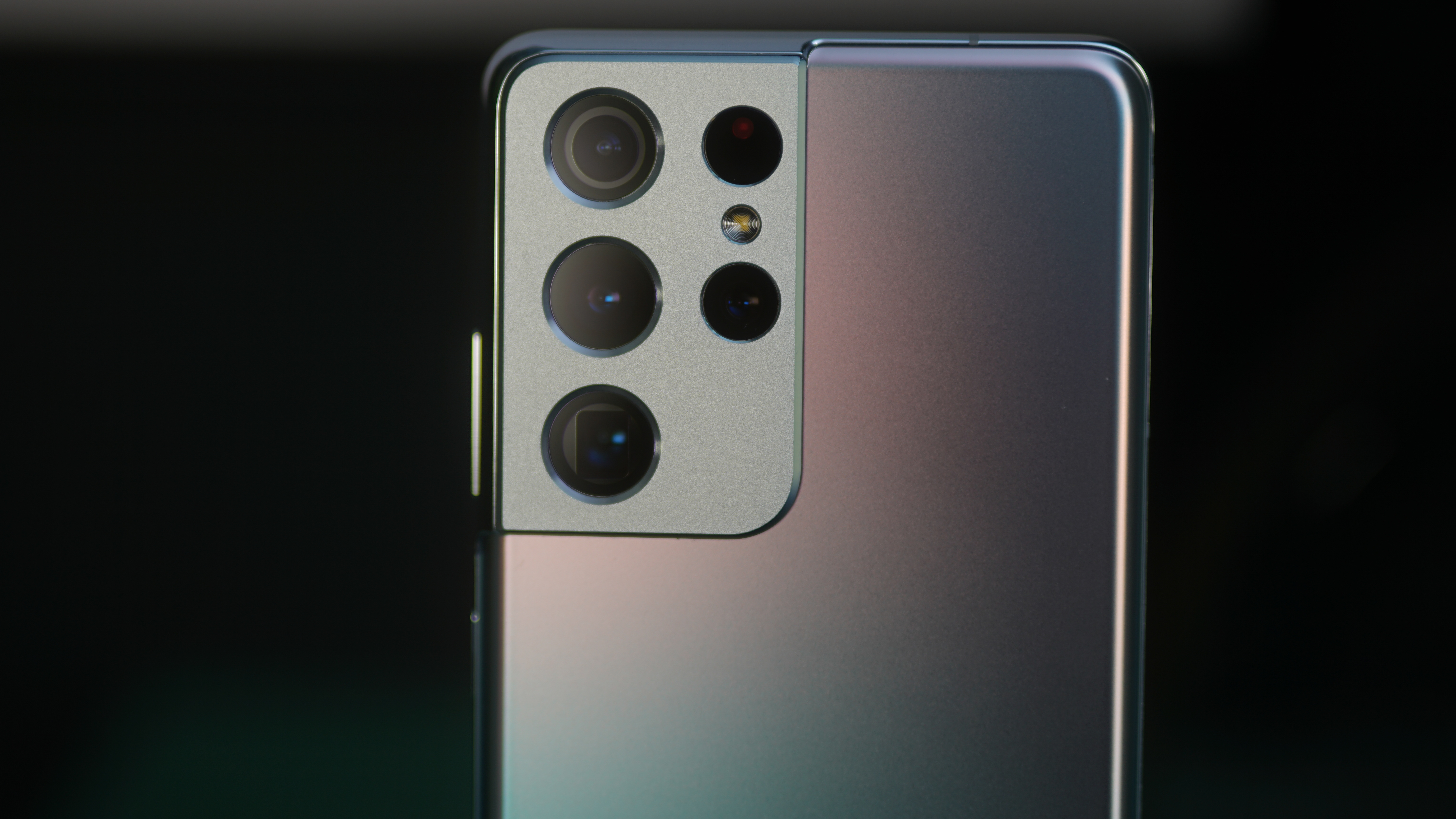
Equally the proper name suggests, everything virtually the Samsung Milky way S21 Ultra is impressive, including the photographic camera setup. Despite its stunning, streamlined design, the S21 Ultra features a quartet of rear lenses. Besides the properly powerful 108MP f/one.8 main sensor, there's a 12MP f/2.2 ultra-wide and – in a bold twist – ii telephoto cameras. Both are 10MP, merely one has an f/2.4 aperture and 3x zoom, while the other has an f/four.9 aperture and a massive 10x optical zoom to go you closer to the action with astounding clarity.
The results are as impressive as the specs: stills are precipitous with good dynamic range. Non-zoomed shots aren't always as skilful as the best rivals, just a wealth of modes – including Director'due south View (which allows yous to shoot footage with the forepart and rear cameras simultaneously) and an improved night manner for finely tuned photos afterwards dark – together with a capable 40MP front-facing photographic camera, brand the S21 Ultra a powerhouse for smartphone photographers.
- Read our in-depth Samsung Galaxy S21 Ultra review
ii. Should you lot become an action cam?
If your aim is to capture life'south adventures on video, you might want to look at an action camera instead of a standard compact or smartphone.
Congenital tough enough to withstand drops, dust and dunkings, the best activeness cams are rugged just simple to utilise. Most come with mounts that allow you to attach them to all sorts of things, from handlebars and helmets to motorcar dashboards and even your pets. Whatever you choose to use it for, a skilful activeness cam should help you capture footage in conditions that would destroy normal cameras.
Well-nigh action cams can shoot expert-quality 4K video through a fixed focal length wide-angle lens. Many are completely waterproof, but some yet ship with a separate waterproof housing for going deeper below the waves. The all-time activeness cams are minor and light enough to not get in the way, straightforward to operate and sturdily built.
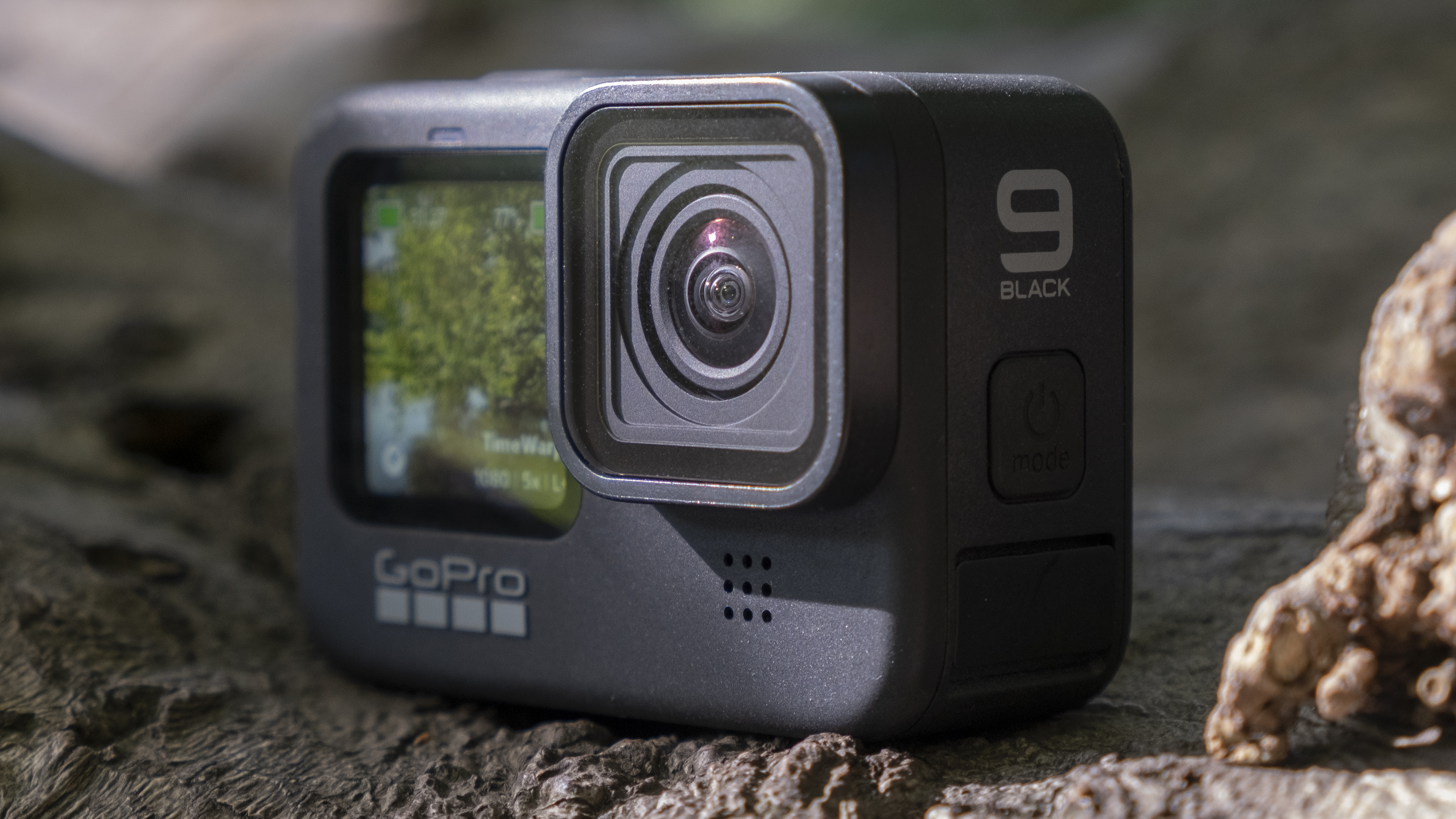
GoPro is the biggest proper noun in activeness cameras and its regularly updated range of Hero models epitomizes everything that's great most the format. They're fabricated to survive some pretty extreme conditions, notwithstanding their touchscreen and button interfaces mean they're piece of cake to control. GoPro cameras can also capture loftier-resolution video, with class-leading paradigm stabilization to proceed fast-paced footage smoothen and steady. Plus they characteristic a range of presets and modes for cinematic creativity, every bit well every bit excellent connectivity options for easy editing and uploading.
While GoPro is the most popular action cam brand, information technology's not alone in the market. From affordable cams that yous won't be afraid to put through the ringer, to flagship recorders from companies like Sony and DJI, there are enough of activity cam options. Some are bullet-shaped for a better helmet fit, while others are modular, pregnant you can switch to different sensor or accessory setups as the situation requires.
Extreme sports enthusiasts naturally gravitate towards activity cams for capturing their adventurous pursuits, but they accept plenty of other uses. Activity cameras are often favored by vloggers, for instance, because of their portability, flexibility and ease of use. They can too be used to shoot in-car footage like a nuance cam, or attached to just most annihilation. The best bit? Unlike a meaty camera or smartphone, wherever you stick an activeness cam, you shouldn't accept to worry about knocks, shocks or rain showers.
Pros: Cheap, tough and simple, surprisingly skilful 4K movie quality in most cases, you can mount them on practically annihilation.
Cons: Fixed broad-angle lenses mean there's no zoom capability, while there's little control over exposure. However photos are snapshot quality only.
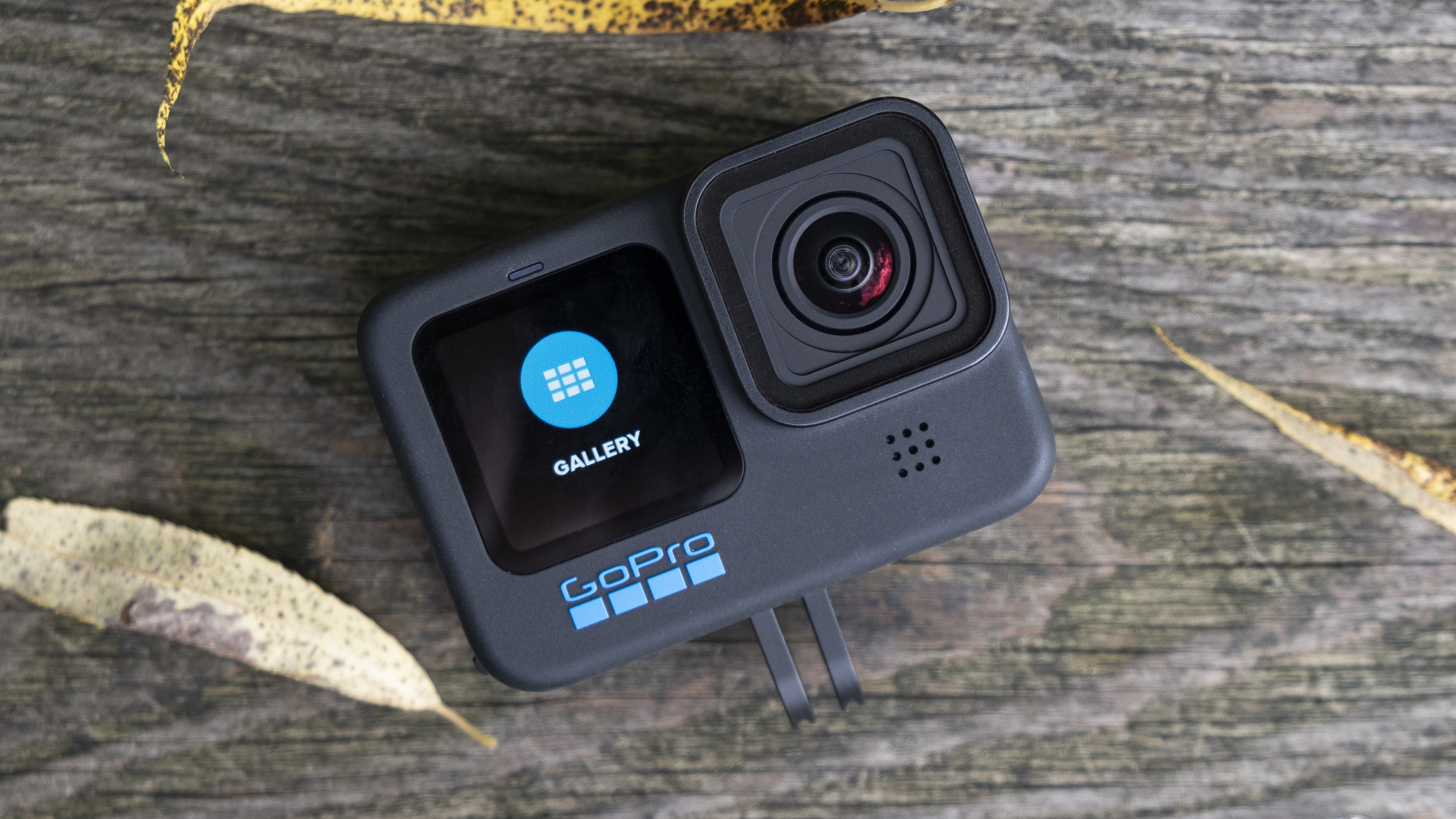
GoPro has long been the brand to vanquish in the action cam loonshit and the Hero 10 Black only cements its position. Featuring the same small sensor, screens and trounce every bit the GoPro Hero nine Black before information technology, the Hero ten Black offers a more refined experienced than its predecessor. Information technology features a snappy touchscreen interface and bill of fare system, accompanied by that handy front screen for framing. Beneath its rugged exterior, a GP2 processor ensures polished performance: it tin can shoot 5K at frame rates of up to 60p, as well as slick 4K slow-mo at 120fps.
Stabilization is stellar equally well, with HyperSmooth 4.0 backed upwards past horizon leveling, which tin keep footage steady even if you tilt to angles of 45 degrees. Alive-streaming of 1080p video is still subject to some limitations (YouTubers demand at to the lowest degree i,000 subscribers), but the power to stream with HyperSmooth 4.0 enabled ways viewers should get a steadier show. Add a hydrophobic lens comprehend to its established endurance skills and the GoPro Hero x Black becomes the clear winner if you need top-notch video in catchy weather – even if budget rivals offer amend value.
- Read our in-depth GoPro Hero 10 Black review
3. Should you buy a travel zoom compact?
Looking to get closer to the action while yous travel? Travel zoom compact cameras combine the portability and simplicity of a betoken-and-shoot with a much longer zoom range that'south capable of capturing a wider range of subjects.
With the rising of smartphone photography, cheap indicate-and-shoot cameras accept declined in popularity. But one surface area where smartphones still fall behind is optical zoom: even the best flagships are express to three-5x zoom, while most rely on electronic trickery to digitally ingather in on faraway subjects. Long-zoom travel compacts seize this as they primary advantage, offering a much, much longer optical zoom range – typically up to 30x.
The idea is simple: you still go a pocketable camera that'south straightforward to use, but the huge telescopic zoom range means y'all tin photograph practically anything you come across on your travels – from beautiful landscapes to distant landmarks. And considering the zoom is optical rather than digital, at that place's far less degradation in quality (peculiarly as the quality of meaty lenses has improved).
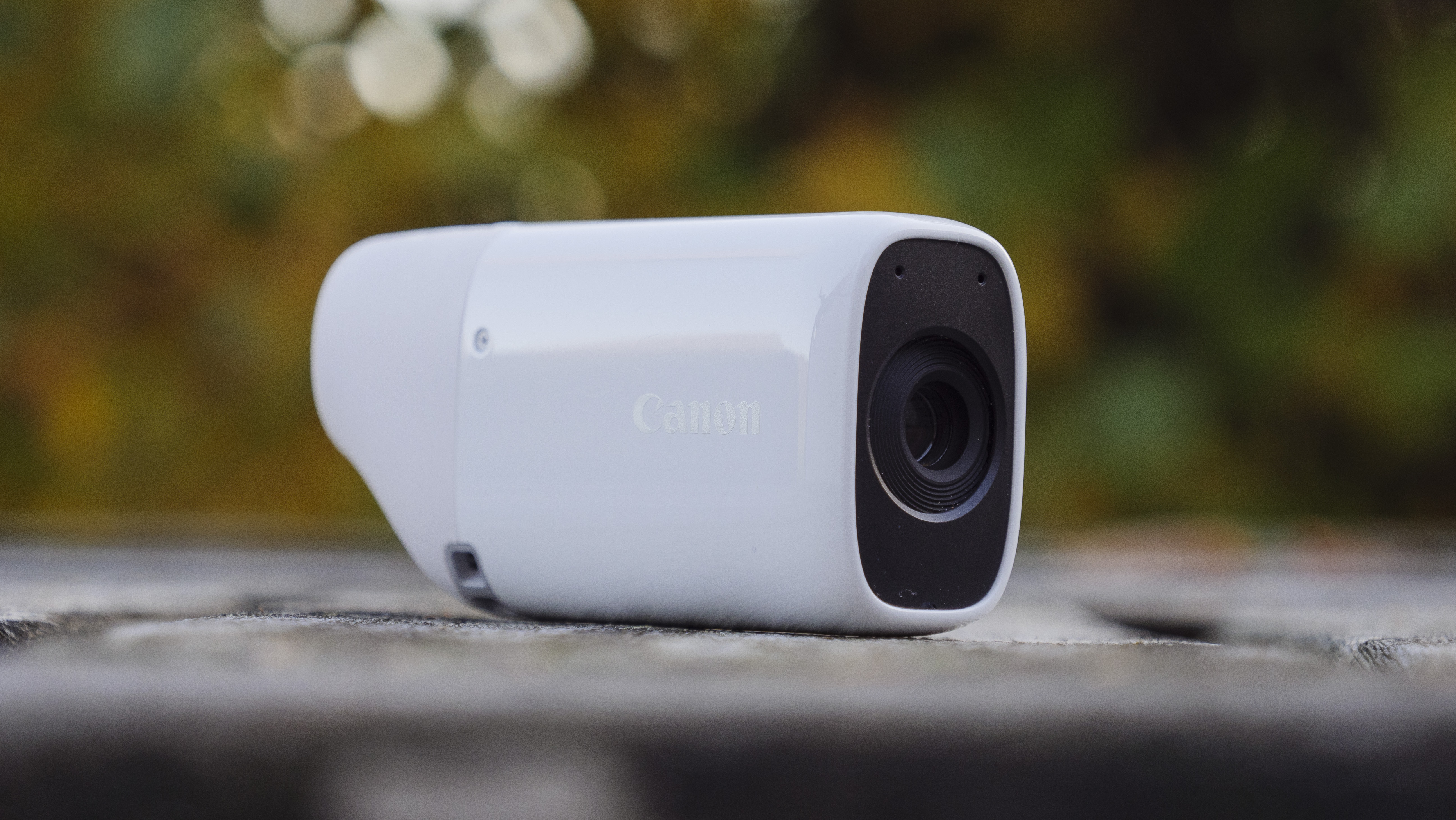
Because travel compacts prize portability, you'll still run across some of the same compromises constitute in a standard compact. Sensor size, for example, is relatively small, meaning low-lite operation normally can't come close to matching a mirrorless or DSLR model. The flip side is that you get long-zoom versatility without needing to stick a bulky telephoto lens barrel in your backpack.
The all-time travel zoom compacts do now apply larger 1-inch sensors, including the Panasonic Lumix Z100 (labelled the Lumix TZ100 outside the US) which is our top option below. This means improved image quality and operation, without sacrificing that all-important portability. Some also offer more advanced transmission command options (such as shutter speed and lens discontinuity command), while the superlative options (including the TZ100 / ZS100) as well feature congenital-in electronic viewfinders.
While smartphones might have sounded the death-knell for affordable bespeak-and-shoot compacts, travel zoom cameras proceed to offering a useful combination of portability and versatility. If you want a camera that'due south small plenty to go in a pocket, yet flexible enough to shoot a whole range of scenarios, they are well worth a expect. After all, you don't desire to miss any in one case-in-a-lifetime photo moments.
Pros: Massive zoom range that copes with nigh whatsoever kind of subject field; quality generally slightly college than a point-and-shoot compact; may have more advanced controls.
Cons: More expensive; however uses a small-scale sensor (with some exceptions) which limits the ultimate picture quality, peculiarly in low-lite conditions.
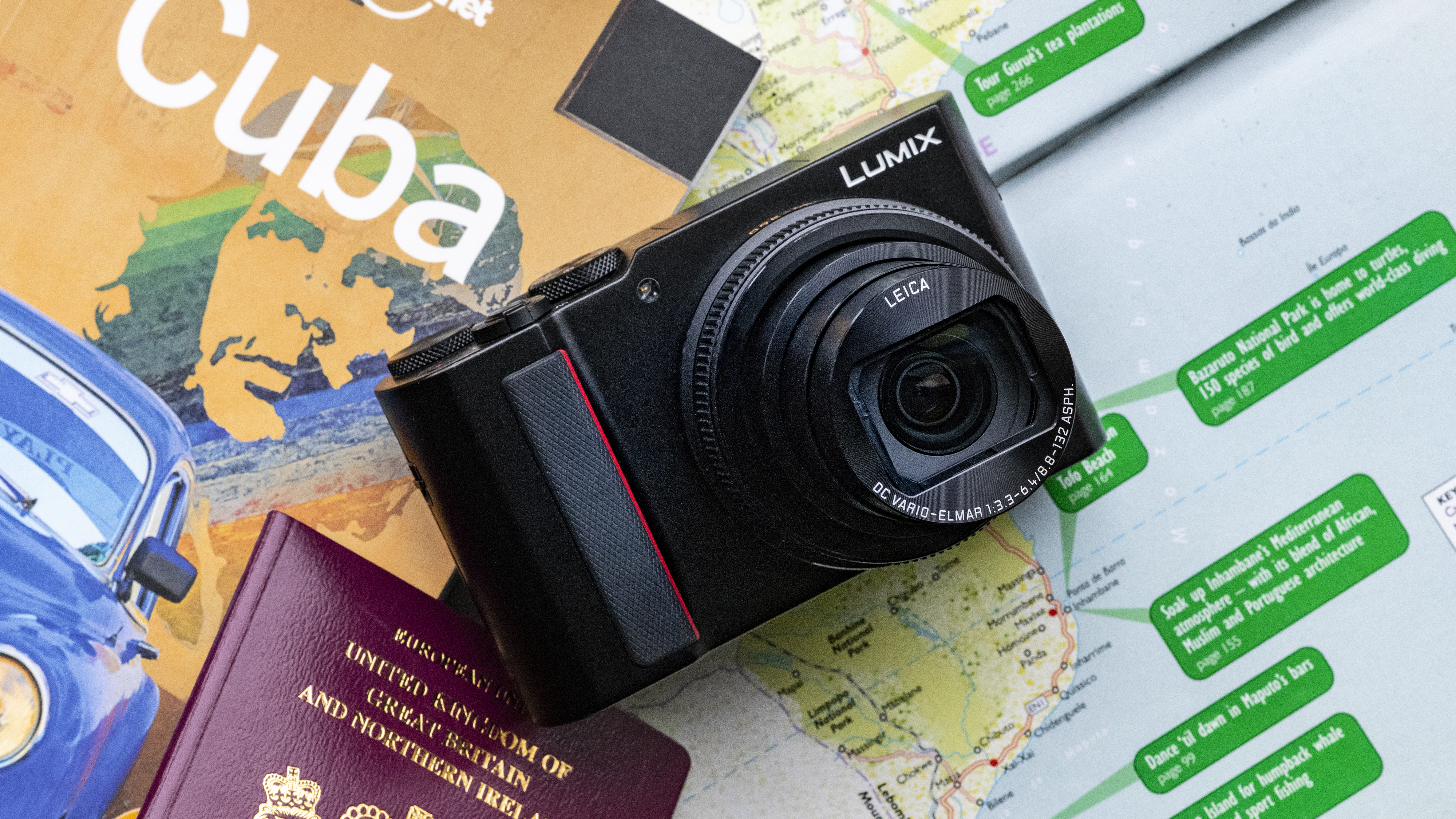
Information technology might non have the longest zoom range for a travel meaty camera, but Panasonic's Lumix ZS200 (known as the Lumix TZ200 outside the US) is our pick of the travel compacts. Panasonic has managed to squeeze a much larger sensor into the ZS200 / TZ200 enables the pixels to be about 2.4x bigger than they are in models similar the Lumix ZS70 / TZ90 and helps the ZS200 produce much college quality images. The 15x zoom ranging from 24-360mm might wait express compared to some rivals, but the optics are decent and for full general photography, you shouldn't demand anything more. You besides get an electronic viewfinder that makes it easier to compose images in bright sunny conditions and 4K video recording. It all adds up to exist a powerful, if pricey option.
- Read our in-depth Panasonic Lumix ZS200 / TZ200 review
iv. Should you buy a span camera in 2022?
Span cameras are the original hybrid camera format. As the proper noun suggests, they span the gap between accessible compact cameras and more advanced DSLR models.
Bridge cameras generally offering the handling and control style of a classic DSLR photographic camera, with a chunky hand grip and defended transmission command dials. Yet they likewise tend to be slightly more than portable than DSLR models, cheers to smaller sensors inside. And instead of interchangeable lenses, yous get a single fixed lens with the kind of massive zoom range normally associated with a travel photographic camera.
Despite the flexibility of their generous zoom ranges (such as the massive 125x zoom on the Nikon Coolpix P1000), bridge cameras are non without their limitations. In order to deliver these zoom capabilities without calculation to the weight or the price tag, many manufacturers utilise the aforementioned 1/two.3-inch sensors plant in compact cameras. So although yous get the wait and feel of a DSLR, you don't get the same prototype quality or operation.
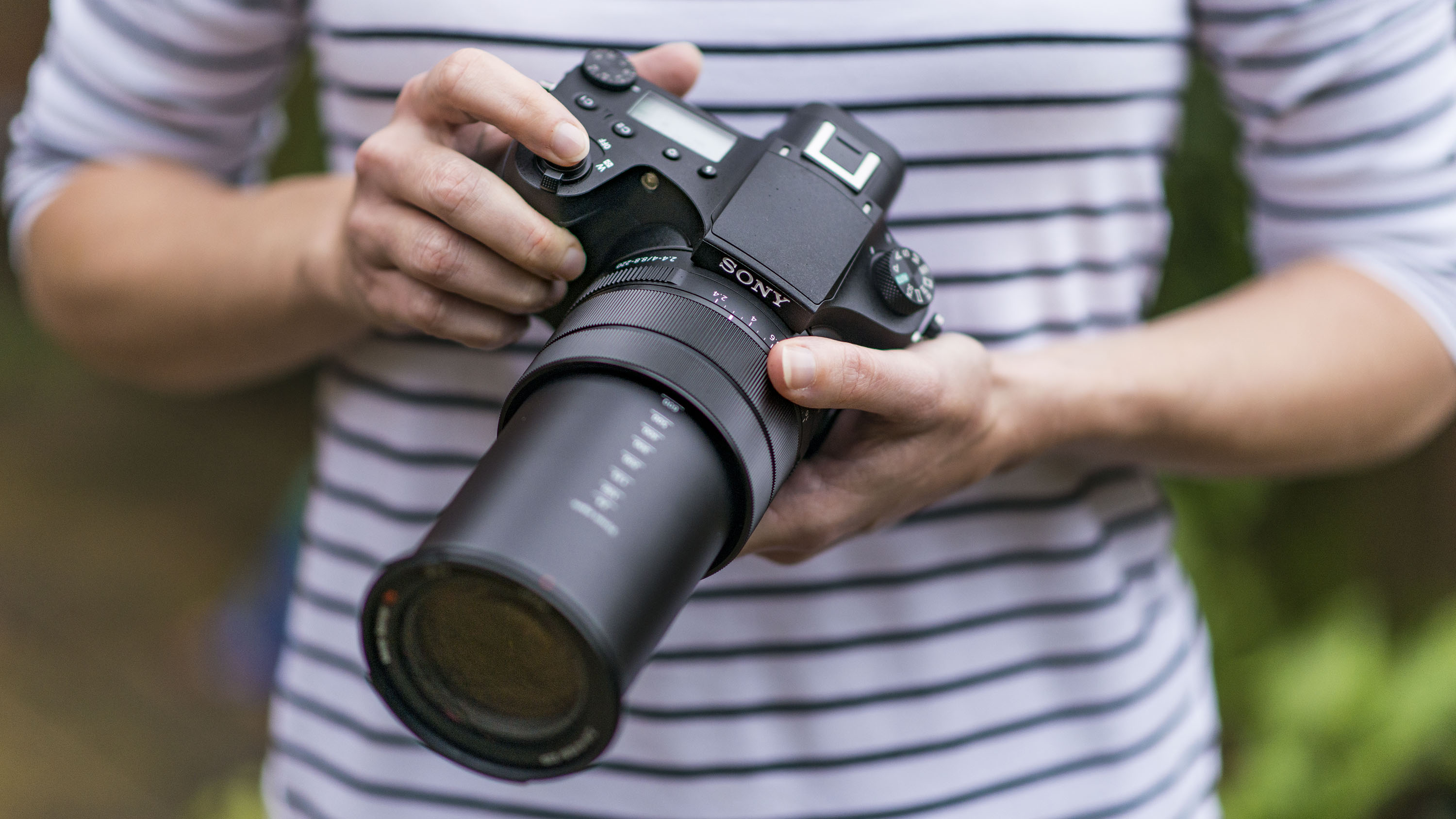
At that place are some exceptions: both Sony and Panasonic accept released bridge cameras with much larger 1-inch sensors. These sacrifice some zoom range for the sake of a large footstep upward in image quality. Both the Sony Cyber-shot RX10 IV and Panasonic Lumix FZ2500 (known as the Lumix FZ2000 exterior the United states of america) characteristic ane-inch sensors, while still delivering decent zoom ranges.
Although fewer new bridge cameras have hit shelves in recent years, the format remains relevant for photographers in a clear niche. They're not pocketable, but they represent an excellent alternative for travelers who'd like the versatility of a wide zoom range, plus the treatment of a larger camera, without having to bear effectually a purse of lenses.
Pros: Massive zoom range; DSLR-style controls and features; versatility and value for money.
Cons: Small sensor size limits the quality (with some key exceptions); item ofttimes quite soft at total zoom; autofocus systems rarely friction match DSLRs or mirrorless cameras for responsiveness.
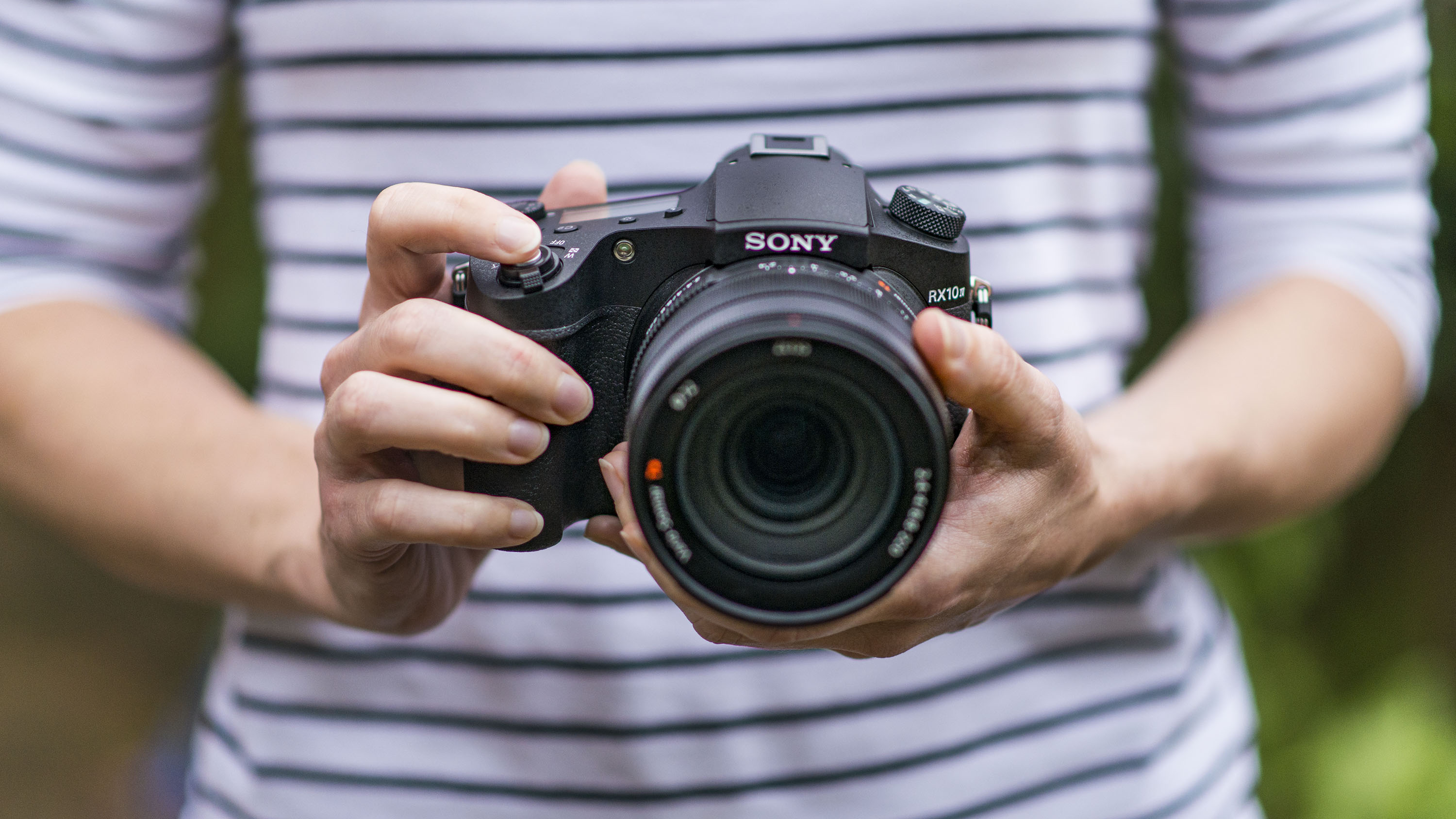
You'll pay a premium for the RX10 IV'due south performance, only when y'all look at what else is out there for the same price, the RX10 IV is nearly in a league of its ain. Featuring a huge 24-600mm f/ii.4-iv zoom lens, the RX10 Iv builds on the RX10 Iii with an overhauled AF organisation that at present does justice to the rest of the camera, while the 1-inch, 20.1MP sensor is capable of achieving excellent levels of detail. That'southward not forgetting the ability to capture video in 4K and shoot at up to 24fps. Impressive stuff.
- Read our in-depth Sony Cyber-shot RX10 IV review
five. Should you purchase a premium meaty camera?
Smartphone photography hasn't killed off the compact camera. Instead, it's highlighted the value of high-stop compacts: these pocketable premium models offer 'proper' photographic performance and epitome quality to embarrass your mobile, in a concrete form that can still sideslip comfortably into a coat pocket.
A premium compact offers a different route to amend images. You lot're not paying for a huge zoom range or DSLR-style treatment. Instead, spending extra nets you a larger sensor, a ameliorate lens, enhanced connectivity and the kind of transmission controls usually reserved for more expensive mirrorless models.
High-cease compact models are designed for enthusiasts and experts who want a camera that'southward small enough to carry around when a regular DSLR or full-frame mirrorless camera would be impractical. Many photographers choose to own a premium compact alongside a larger interchangeable lens camera. By carrying one in their pocket at all times, they know they'll e'er have a capable tool to capture unexpected shots.
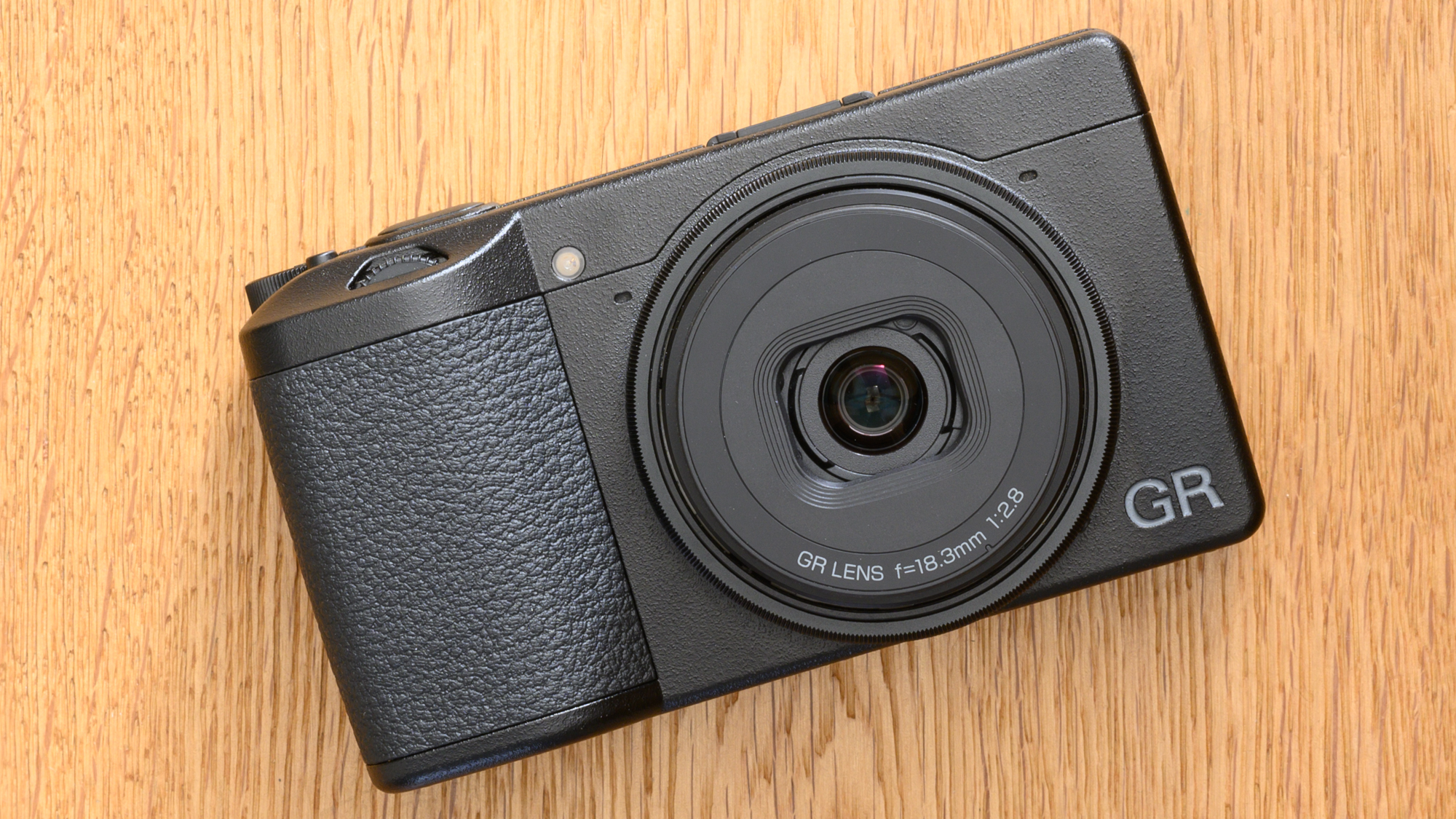
Zoom range is rarely special on a premium compact (it's normally well-nigh the same as you'd get from a regular point-and-shoot). Some even opt for a fixed focal length. The pay-off is a bigger sensor that leaves smartphones and standard compacts for dust when it comes to depression-light photography and outright image quality (usually aided past a ameliorate, broad-aperture lens).
Many premium compacts today apply big 1-inch sensors, such equally the Panasonic Lumix ZS200 / TZ200 and Canon PowerShot G7 10 Marker III. Some find space for a Micro Four Thirds sensor (like the Panasonic Lumix LX100 II) while the very all-time manage to clasp in an APS-C sensor, which is the same size equally you'll find in many mirrorless and DSLR cameras. Which is one of the reasons why the Fujifilm X100V is our favorite premium compact for those who can afford it.
Pros: DSLR features and DSLR-budgeted quality in a pocket-sized camera.
Cons: Even the cheapest aren't cheap, and the most expensive really are expensive; you can't change lenses.
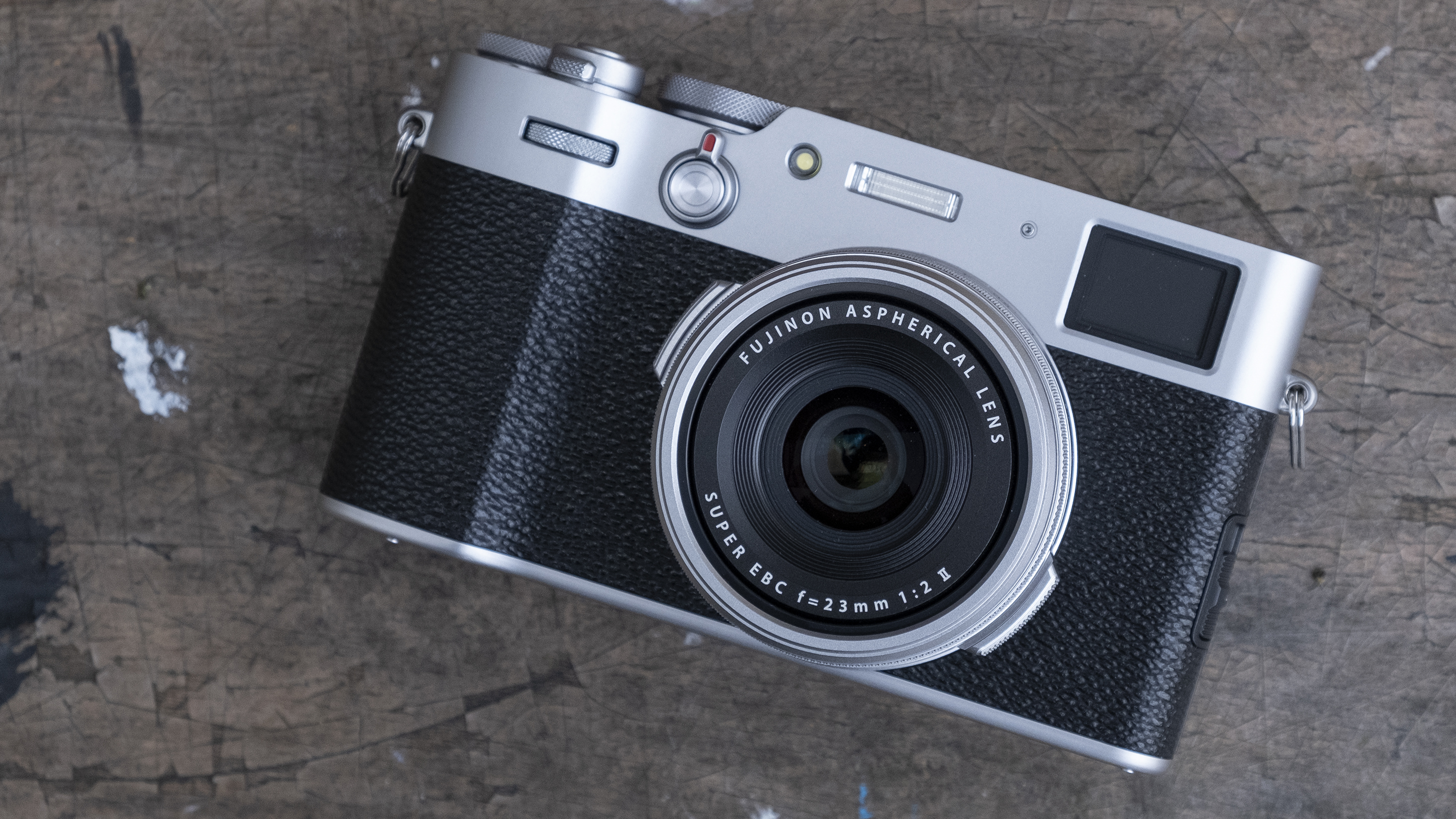
A different kind of photographic camera, the Fujifilm X100V combines the capabilities you'd expect from a premium compact with the iconic retro styling of an analogue camera from the Fifties. Somehow it works. With a 26.1MP sensor and a powerful X-Processor 4 at its disposal, image quality was never in dubiousness. What the X100V doesn't take is the kind of zoom range that some might like.
Instead, you go a fast, fixed focal length 23mm f/2 lens that's perfect for street and portrait photographers. And then likewise is the speedy autofocus and solid low-light dissonance control. You also get a high-resolution hybrid viewfinder, plus a useful tilting touchscreen for straightforward framing and 4K at 30fps for detailed footage. Yep, the cost will be prohibitive for some, while the absenteeism of atmospheric condition-proofing means it isn't a camera for all atmospheric condition. All the same, yous won't find many other premium compacts with this set of skills – and none with such a hitting throwback beat out.
- Read our in-depth Fujifilm X100V review
half dozen. Should I buy a DSLR in 2022?
DSLR cameras are no longer considered the cut-border choice for serious photographers: with the rapid advancement of mirrorless models, those are now the summit option if y'all want a high-performance photographic camera. But there'south nevertheless enough to be said for the DSLR format in 2022.
Also big sensors for superior image quality and interchangeable lenses for unrivaled versatility, DSLR cameras also offering a fundamentally different user experience. DSLR cameras are famed for their bigger bodies, which feature chunky, ergonomic grips that are comfortable and forgiving to employ. They also feature optical viewfinders which allow y'all to see through the camera's lens while framing, besides as superior battery life. Plus the all-time DSLR cameras take sensor resolutions to rival the top mirrorless options.
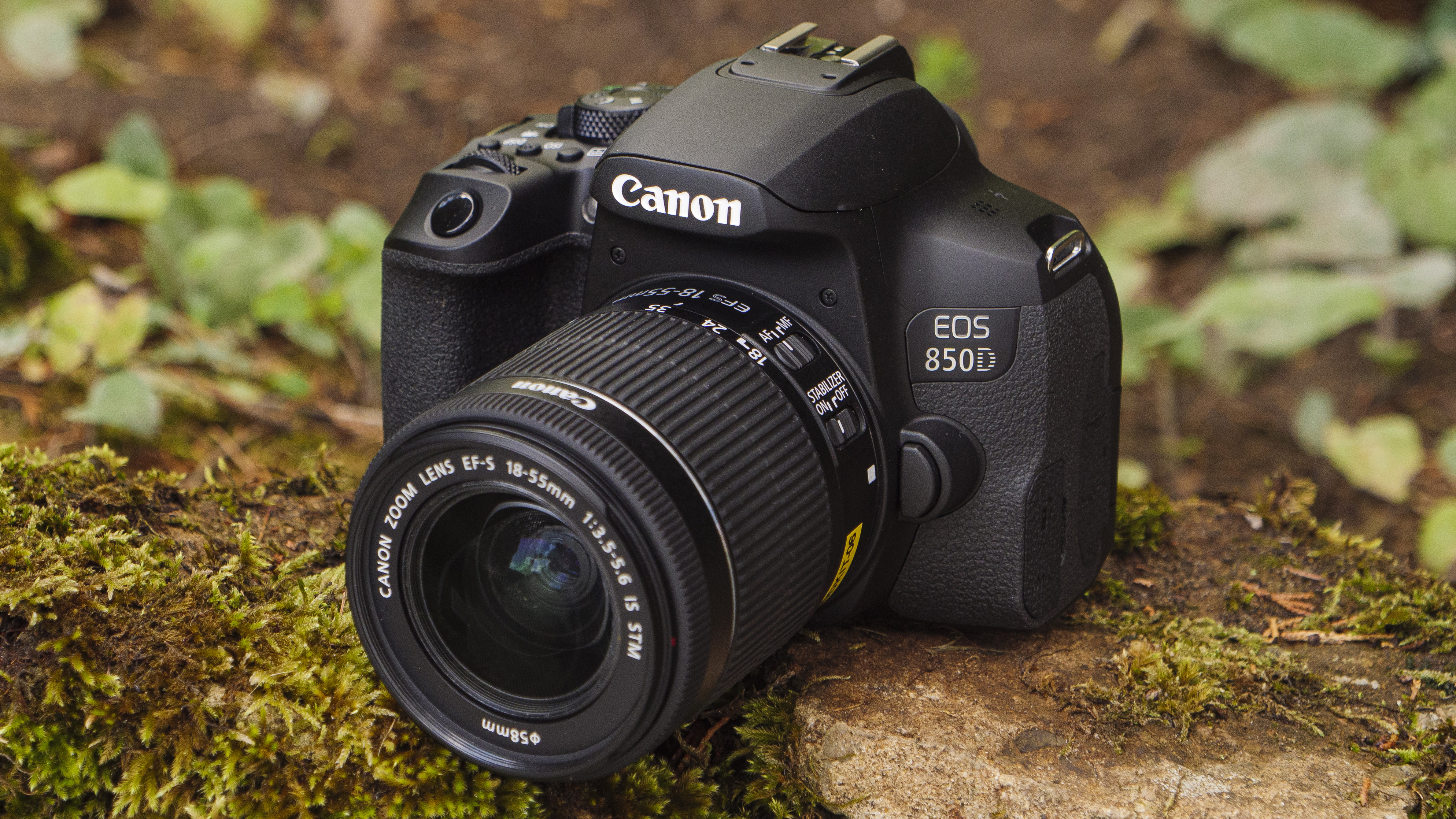
DSLR cameras remain an first-class choice for students, as well. There are many entry-level options which offer an affordable route into DSLR photography. Learners often discover the larger grip and accessible controls go far easier to explore the bones principles of photography, while manual settings and multiple preset modes mean you lot can affordably experiment with more artistic shooting as your skills improve.
The option to change lenses as well opens up a new world of opportunities. DSLR cameras will ordinarily send with a 'kit' lens that's designed to comprehend a range of everyday focus lengths. From at that place, you lot tin can diversify based on your style of photography. That might mean a telephoto for safari shots, a super-wide-bending for huge landscapes, a macro lens for extreme close-ups or a fast prime lens for sharp low-light street shots with dramatic depth of field.
Although mirrorless models are pushing the boundaries of functioning in 2022, DSLR cameras are notwithstanding a great option for many photographers. For beginners, they represent an accessible entry route into more advanced photography. For enthusiasts, the larger sensors and interchangeable lenses won't limit extermination. And for more serious snappers, the best full-frame DSLR cameras tin can nonetheless compete when it comes to outright image quality.
Pros: Interchangeable lenses; full transmission controls; raw files; APS-C sensor for a big footstep upward in quality.
Cons: Big and bulky compared to most compact cameras; focusing in 'live view' on the rear screen is comparatively sluggish on near models.
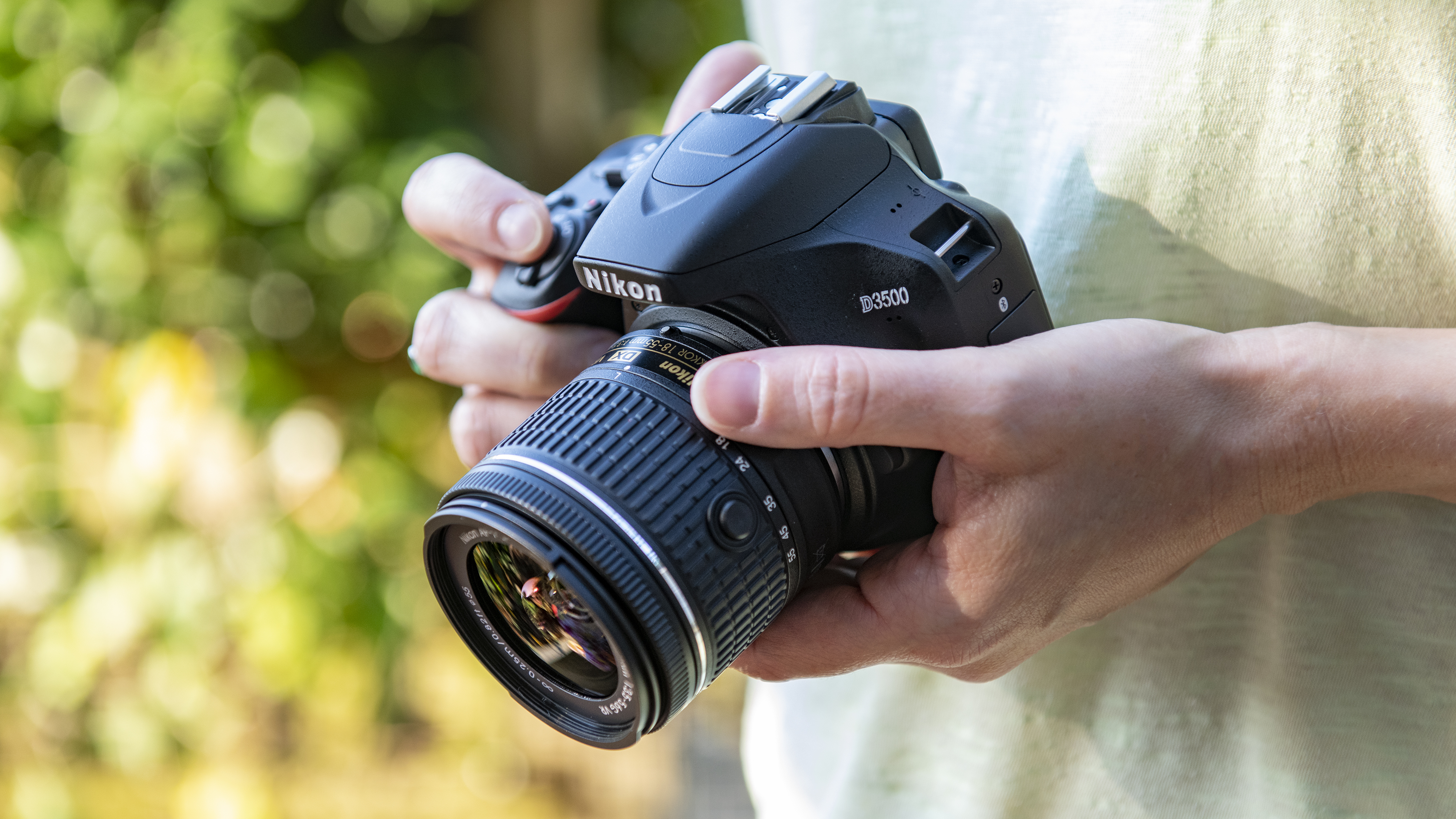
Nikon's D3500 builds on the brilliant D3400, which was until recently our summit entry-level DSLR pick. Nikon's D3500 is our top pick when it comes to entry-level DSLRs. While it shares quite a few features with the D3400, upgrades for the D3500 include a new 24.2MP sensor, improve bombardment life (to a staggering i,550 shots) and refined exterior controls. Its clever Guide Mode is a useful learning tool that gives existent-time explanations of important features. There's no touchscreen, but otherwise this is our favorite entry-level DSLR correct at present.
- Read our in-depth Nikon D3500 review
- Check out our guide to the best beginner DSLRs you can purchase
vii. Is a mirrorless photographic camera worth the money?
Mirrorless cameras are fast becoming the format of pick for enthusiasts and experts alike. Similar DSLR cameras, they feature large sensors and support for interchangeable lenses. But they're also more compact and tend to deliver more advanced operation and connectivity options.
As the name suggests, in that location's no mirror inside a mirrorless camera. That ways they tin can be made both smaller and lighter than their chunky DSLR cousins. It also means that, instead of optical viewfinders, mirrorless models often rely on electronic equivalents for framing. These are normally small, sharp and bright OLED panels which show you the paradigm as yous'll capture it, rather than the existent analogue scene in front of you. Whether this appeals will be a matter of personal preference.
Many cheaper models don't come up with a viewfinder at all, meaning you lot'll demand to apply the rear screen. This can be a disadvantage in certain scenarios, but improvements to touchscreen engineering mean that many mirrorless models now feature seamless interfaces which will be familiar to smartphone photographers.
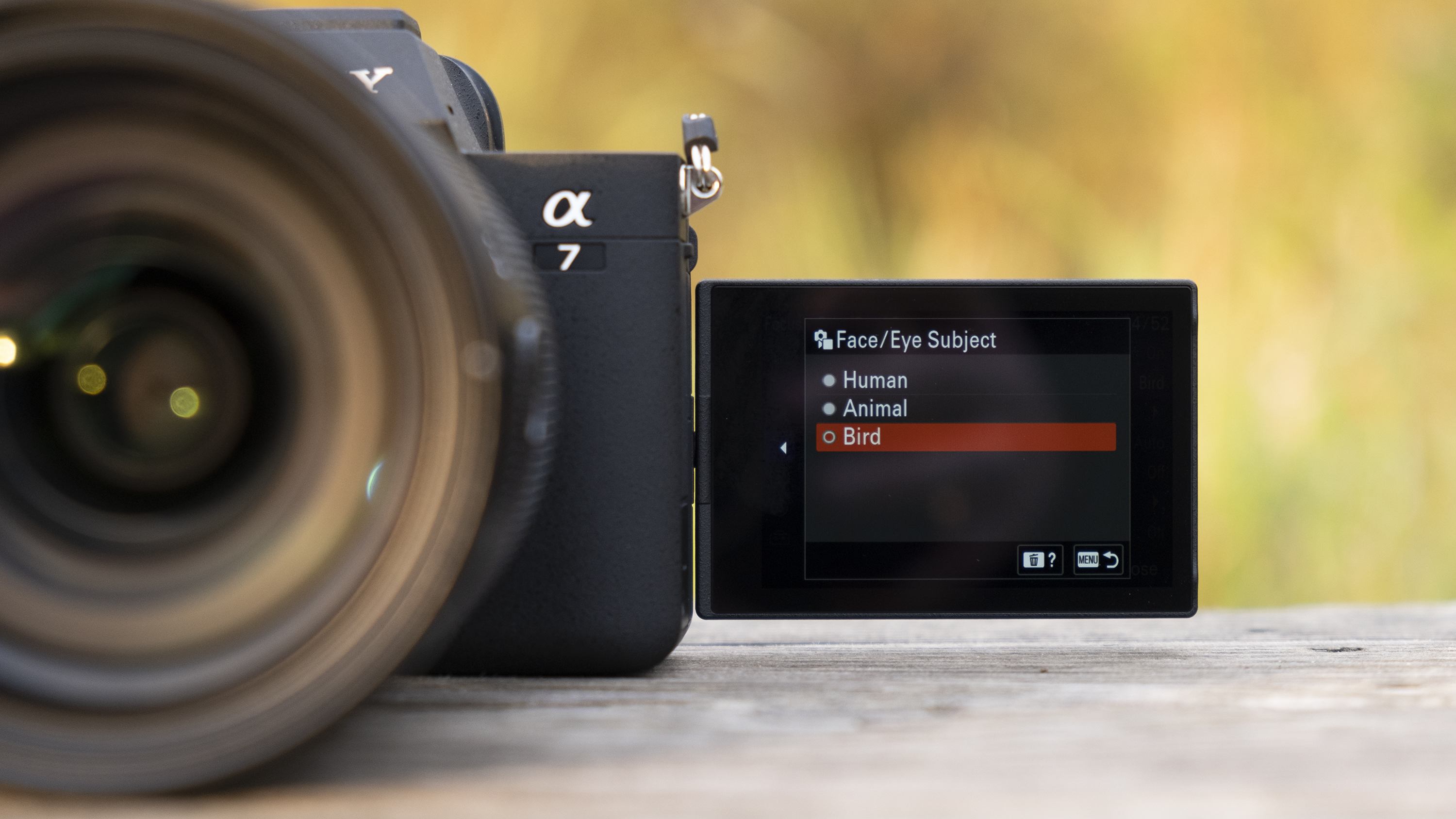
Mirrorless cameras are available in a broad range of styles. Y'all can detect relatively affordable entry-level options which are designed for portability and ease of employ, with creative modes to help beginners learn the ropes of photography. You'll as well notice mirrorless cameras that are dedicated to videography, with many well-known vloggers using mirrorless models to shoot sharp 4K video (and better). Some of the latest options even let y'all to live-stream footage via Wi-Fi.
The most sophisticated and expensive mirrorless cameras characteristic total-frame sensors and stunning performance, with super-fast and authentic autofocus, also as blisteringly quick outburst shooting speeds and huge resolutions. These flagship cameras aren't cheap, but they represent the time to come of photography, with near manufacturers pouring their time and development budgets into delivering better and better mirrorless applied science.
Pros: Pocket-sized and light; mechanically simpler than DSLRs; full time 'alive view' with fast autofocus.
Cons: Some models don't accept viewfinders; electronic viewfinders lack the clarity of a DSLR's optical system.
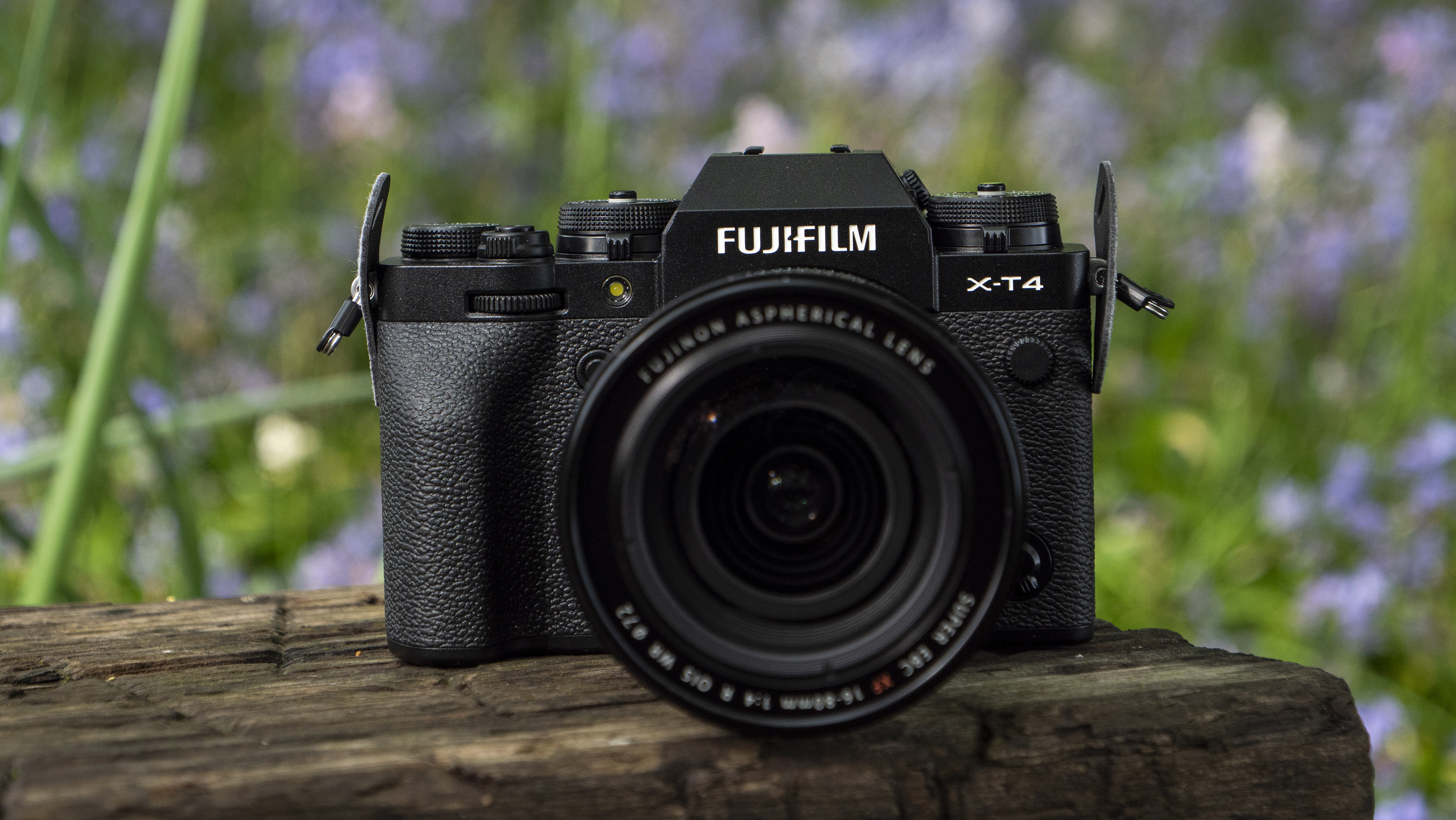
Don't let its gorgeous analogue styling fool y'all: the 10-T4 is the opposite of sometime schoolhouse. A truly modern hybrid, the X-T4 is Fujifilm'due south virtually avant-garde APS-C photographic camera to day, with a compelling combination of features that make it an outstanding all-rounder. Solidly built and conditions-resistant, it's a lovely camera to handle, with a fully articulating touchscreen for painless framing. Performance is superlative beyond the board: with the same form-leading 26.1MP sensor as the X-T3 before it, no other camera can match the X-T4's detail or low-light skills.
Adding IBIS into the mix only makes things ameliorate, with effective five-axis stabilization available for stills and video (which the 10-T4 is also very skilful at, with support for Cinema 4K at up to 60fps, too as ten-bit internal recording, up to 400Mbps bit-charge per unit and F-Log and HLF profiles as standard). Autofocus performance potential can exist limited by lens choice, but improved heart- and face up-detection work very impressively. Beefier bombardment life complements the setup, while Wi-Fi and Bluetooth connectivity should brand up for the absent headphone port. It might be pricey, but the X-T4 is a remarkable selection for those who want the latest mirrorless power in a charming, intuitive bundle.
- Read our in-depth Fujifilm X-T4 review
eight. Should I buy a full-frame camera?
Nearly enthusiast DSLR and mirrorless cameras use an APS-C sensor. Larger than smartphone or compact sensors, these are unremarkably capable of capturing splendid images fit for well-nigh photographers, without requiring a bulky camera body. Simply if you want even higher quality, there's only one way to go: full-frame.
The key advantage of full-frame is sensor size: the same as quondam 35mm film, full-frame sensors are twice as large again as their APS-C equivalents. That means higher resolutions for sharper stills, larger pixels for improved low-light photography and all-circular amend image quality.
Although full-frame cameras have long been popular with professionals, they're increasingly accessible to enthusiasts. While the likes of Canon and Nikon keep to offer flagship full-frame cameras with massive cost tags, the appearance of full-frame mirrorless models for the consumer marketplace ways there's more variety and value available than ever.
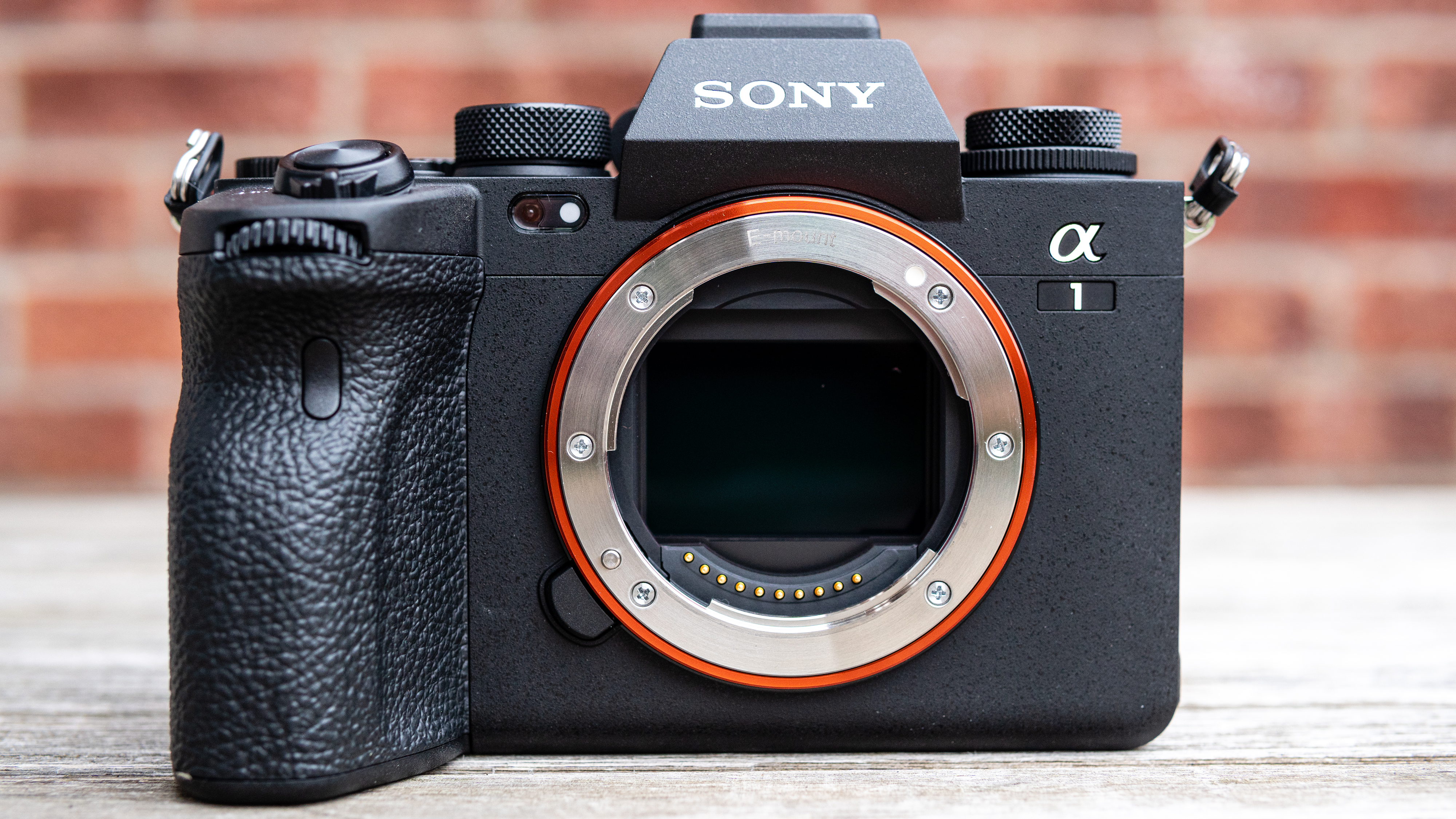
That said, switching to a full-frame camera will yet require a step up in expenditure. Whether this is worth it for you will depend on what and why you like to shoot. Total-frame cameras capture the kind of item that allows you to blow upwards big prints of your pictures. The Canon EOS R5, for example, features a 45MP sensor resolution. That also means you can ingather in on details in a scene. Plus the best total-frame cameras are fantastic subsequently dark.
But there are other compromises to consider alongside the toll. Besides existence overkill for near people, the increased sensor size likewise means total-frame cameras tend to be bigger and notably heavier even than mirrorless models. And while the ingather factor of a full-frame camera captures a wider field of view (and therefore makes it easier to get a shallow depth of field), you have to work harder to shoot close-ups of afar objects.
If you lot do want to take the full-frame plunge, you're spoilt for choice in 2021: the Panasonic S serial, the Catechism EOS R collection, Sony's a7 mirrorless range, plus Nikon's Z6 and Z7 models – equally well equally Leica's M rangefinders and a host of DSLR options. Equally yous can see, there's no shortage of total-frame cameras to choose from.
Pros: Maximum quality thank you to the full-frame sensor; ofttimes designed for tough, daily use; high resolution or loftier continuous shooting speeds a speciality
Cons: Expensive to buy and that goes for total frame lenses, besides; pro models are bulky and heavy
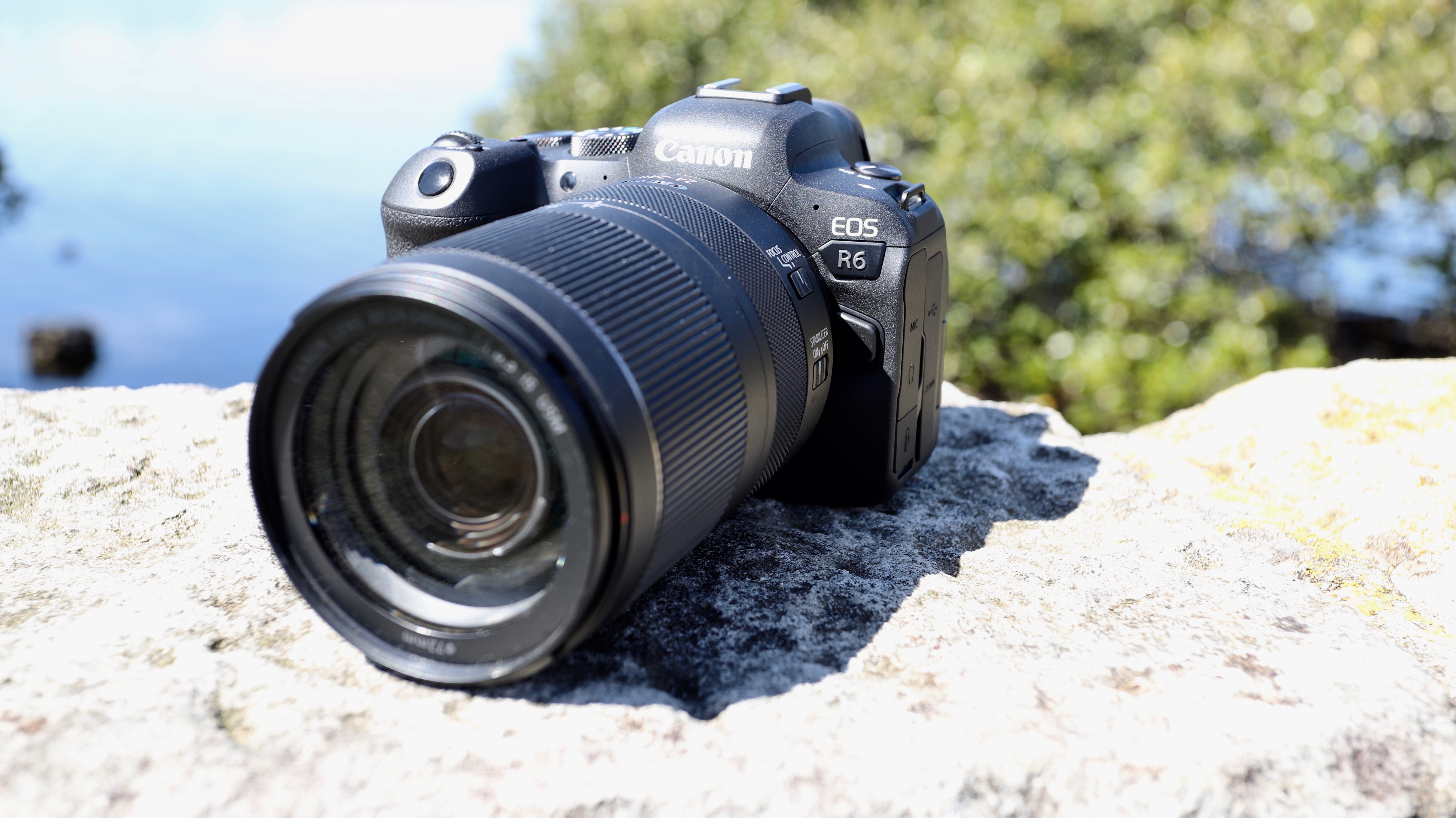
In Canon's line-up, the EOS R6 is technically a more affordable, dialled-down version of the flagship R5. Only in reality, it's one of the best mirrorless all-rounders you can purchase. At twenty.1MP, its total-frame sensor packs a lower pixel count than many competitors. And at 4K/60p, its video resolution doesn't come close to the 8K offered past the R5. Even so as a consummate package, the EOS R6 is a joy to shoot with: Dual Pixel autofocus proves fast and authentic, while Canon's first endeavour at in-body image stabilization is outstanding.
Capturing action? 12fps mechanical outburst speeds spring to a speedy 20fps when you switch to the electronic shutter. Dynamic range can be disappointing, with a lack of particular in highlights, simply colour reproduction is excellent and dissonance handled well. Its ergonomic design also means the R6 is comfy enough for all-day apply. At that place's no question it's a huge upgrade from the EOS 6D Marking II, the EOS R or the EOS RP. The central issue is cost: there are full-frame alternatives available with more pixels for less coin. But few that are quite as compelling.
- Read our in-depth Catechism EOS R6 review
9. Should I buy a video camera?
Photography isn't just about stills any more. While video was once a completely different discipline, almost every decent camera in 2021 tin can tape sharp footage in Full Hd or 4K. Even smartphones can at present capture the kind of video which would embarrass camcorders of old.
But in that location's a deviation betwixt a photographic camera that tin shoot solid video clips occasionally and a model that has the skills to tape consistently good footage in all kinds of weather. Mirrorless cameras are now the driving force backside video technology, with the format favoured by everyone from YouTube superstars to documentary makers.
Whether it's worth buying a video-focused camera depends on what yous desire to shoot and what you lot want to exercise with the footage later on. If you're capturing quick clips to share on social media, today'south superlative-cease smartphones volition near ever deliver the goods.
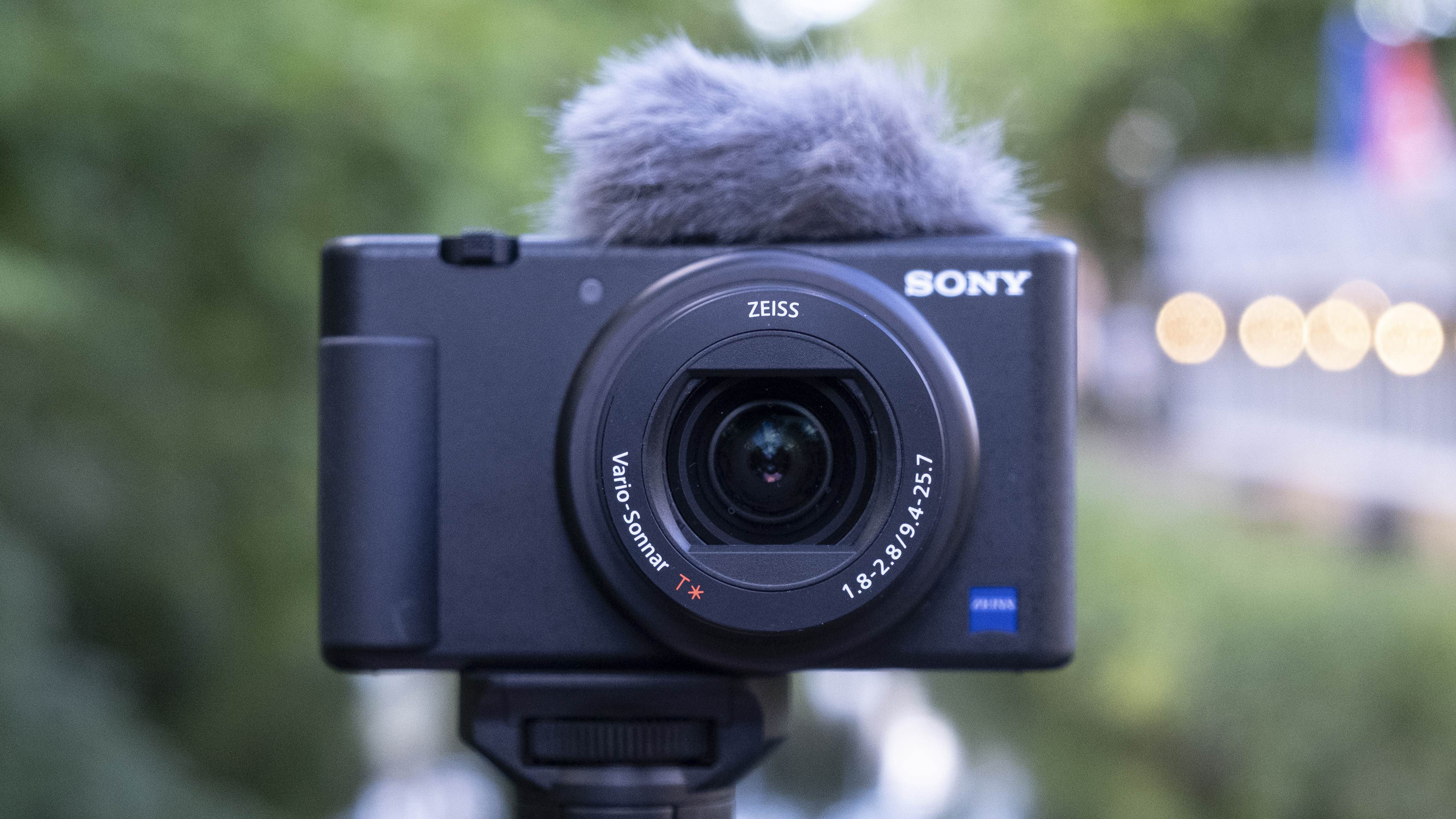
Smartphones won't terminal long in extreme surround, though. If you want to tape more than adventurous pursuits, it's worth considering a dedicated activeness camera similar the GoPro Hero 10 Black. These cameras are built to be rugged yet like shooting fish in a barrel to use, with a range of artistic shooting modes – plus class-leading stabilization skills – which allow you to shoot professional-looking footage in tricky conditions.
You could besides consider the new armada of pocket-friendly video tools, from the tiny Insta360 Go 2 to the compact DJI Pocket ii, which features a small-scale mechanical gimbal to keep shots steady. These connected cameras are all virtually video: they're designed to make great shots accessible wherever you lot go. And don't discount premium compact cameras (similar the Sony ZV-1) if you need something portable but powerful for shooting on the move.
But if you lot want the very all-time video quality, mirrorless is the answer. Cameras similar the Canon EOS R5 can record incredible 8K footage, although 4K is ordinarily more than enough. There are several mirrorless cameras which are dedicated to videography, such every bit the Sony A7S Iii, plus a number of hybrid all-rounders like the Fujifilm 10-T4.
These cameras normally offer features which make information technology simpler to shoot excellent footage, such every bit tilting touchscreens for easier framing and processors powerful plenty to support the frame rates required for polish tiresome-mo. A few, including Panasonic's GH5 II beneath, even allow you live-stream straight to certain social platforms. The best mirrorless video cameras also support a range of file formats and colour profiles which add flexibility for editing.
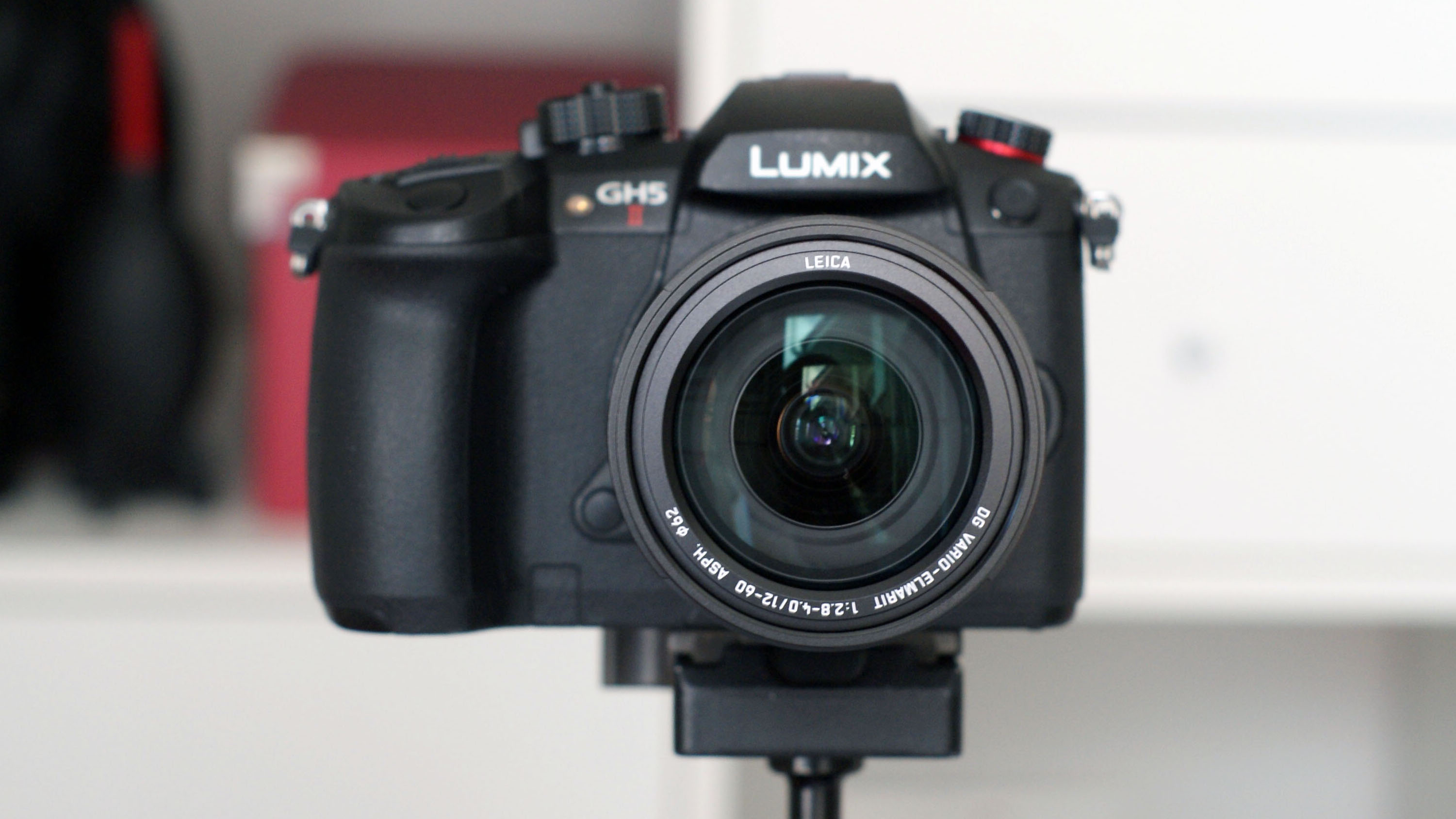
The GH5 Mark Two takes the capable foundation laid by the GH5 and makes several small improvements. Both the sensor and the body are the same, and then you become a well-congenital, lightweight mirrorless camera with splendid handling. And like the original, it'southward an first-class 4K camera with a total complement of videography skills: it can shoot gorgeously sharp footage, with support for 10-scrap iv:2:two video and buttery polish slow-mo.
Depression-low-cal operation is limited past the Micro 4 Thirds sensor, but 5-axis epitome stabilization performs well. Autofocus is accurate, plus the forward-facing screen is handy for framing yourself. While those features alone don't justify upgrading from the first-gen GH5, wireless live streaming might: the Marking II is the only mirrorless camera to currently offer cord-free video manual in real fourth dimension via the RTMP/RTMPS protocol. Quality adjusts based on connection strength, with a cap of 1080/60p – which should be fine for YouTube or Facebook, which are both supported out of the box.
- Read our in-depth Panasonic GH5 Mark II review
- These are the earth'south all-time cameras for photography
Source: https://www.techradar.com/news/what-camera-should-i-buy
Posted by: lottwasso1969.blogspot.com


0 Response to "What To Look For In Camera"
Post a Comment